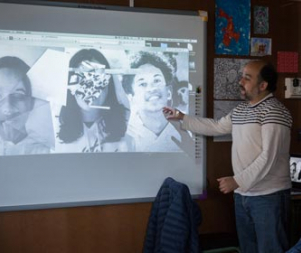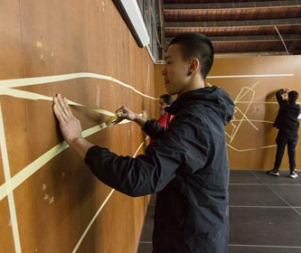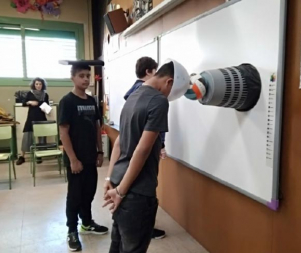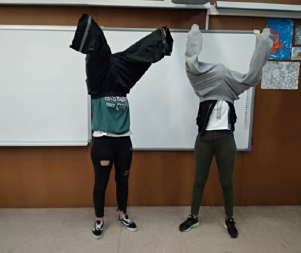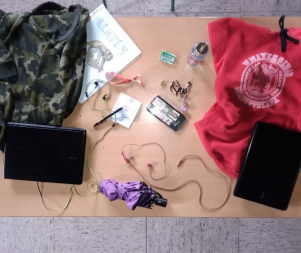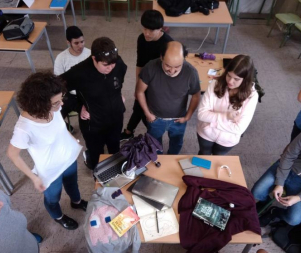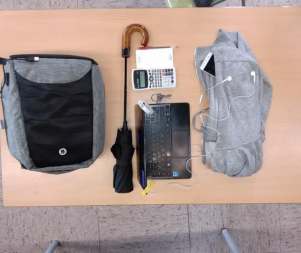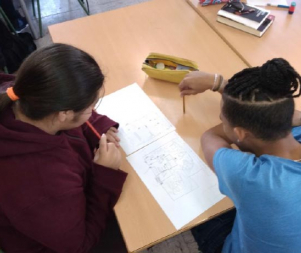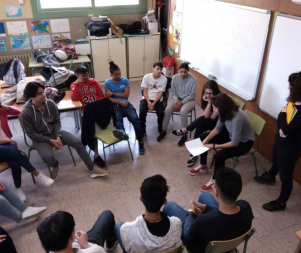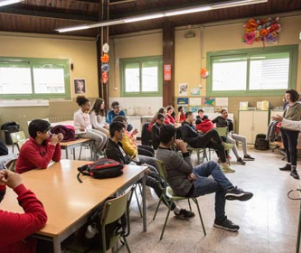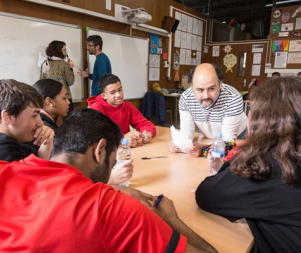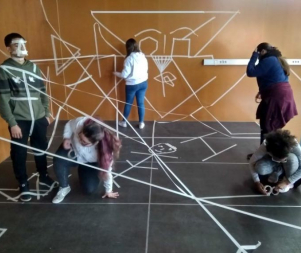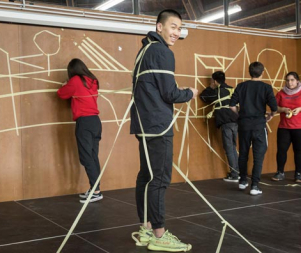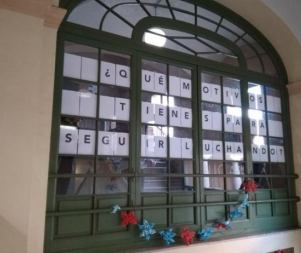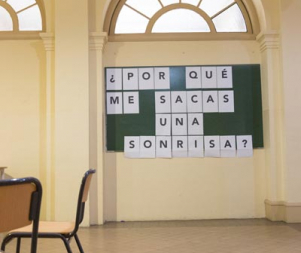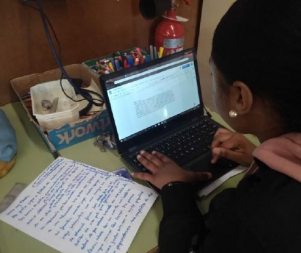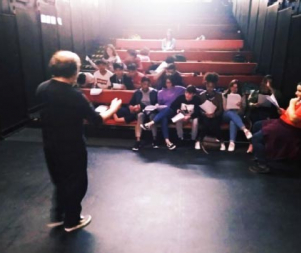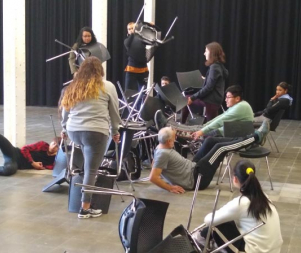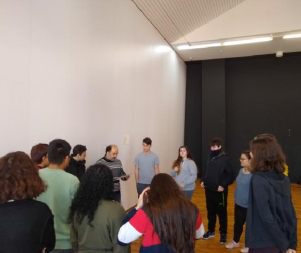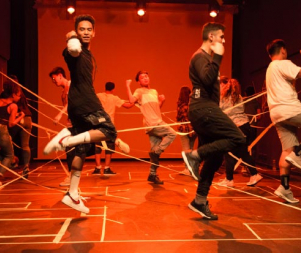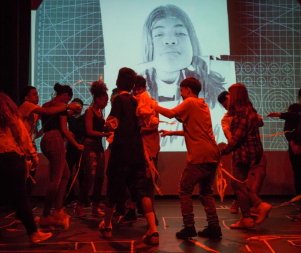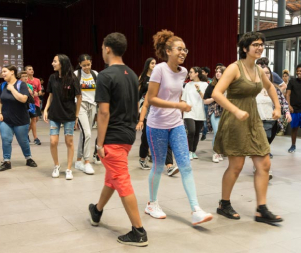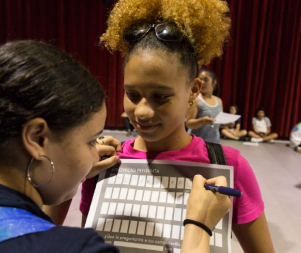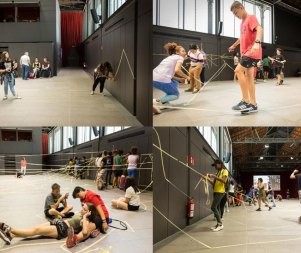- 14th EDITION 2022 / 2023
- 13th EDITION 2021 / 2022
- 12th EDITION 2020 / 2021
- 11th EDITION 2019 / 2020
- 10th EDITION 2018 / 2019
- 9th EDITION 2017 / 2018
- 8th EDITION 2016 / 2017
- 7th EDITION 2015 / 2016
- 6th EDITION 2014 / 2015
- 5th EDITION 2013 / 2014
- 4th EDITION 2012 / 2013
- 3rd EDITION 2011 / 2012
- 2nd EDITION 2010 / 2011
- 1st EDITION 2009 / 2010
Txalo Toloza i Laida Azkona IN RESiDENCE at the School Pau Claris
The project had three main stages: the first, landing and mutual knowledge; the second, consolidation with the contamination sessions and the third, preparing and producing the final presentation. At the same time, other activities were carried out, in parallel to the In Residence project that had initially been planned, which helped to strengthen and establish networks with the city’s other structures and cultural realities. These are described in detail below.
A) FIRST STAGE (OCTOBER-DECEMBER): "LANDING" and MUTUAL KNOWLEDGE
Start: exercises for getting to know one another
The students carried out various exercises during the first few weeks, some aimed at helping the students to get to know one another better and which helped them to immerse themselves in the artistic world of Laida and Txalo.
Discovering the artistic language of Txalo and Laida: video-dance, installations, the body and its relationship to the space.
The students opened up their rucksacks to explain who they were By opening up their rucksack, the students learnt that it was possible to know a lot about a person by finding out what they kept inside their bags.
They also created a picture out of the items they were carrying in their rucksacks.
Sketching the house they lived in as young children, the students spoke about themselves
Shortly before the holidays, the student began working on a new activity: they had to sketch the house they had lived in as young children. Bearing in mind that most were born abroad, this was another exercise for getting to know one another that helped them to get closer to each another.
They were paired off and afterwards, when it came to explaining their homes, one would show a map and discuss their partner's memories. And if something was not remembered, it could be invented. In the end, the group photo taken of everyone was practically a map of the world's houses.
B) SECOND STAGE (JANUARY-APRIL): "STARTING AGAIN" AND CONTAMINATION SESSIONS
The Question Project: questions that generate questions.
After they had returned from their Christmas holidays, the students then started the Question Project. Txalo told them that this was a mechanism devised by a group of Chilean artists. The goal was to reawaken the group’s attention, having been a little unfocused after the Christmas holidays.
The Question Project was a citizen-participation and art mechanism devised by the Mil M2 collective. It was with this very simple dynamic that the collective make the various groups of people use questions to express their concerns with regard to the social life in their local neighbourhood.
Mil M2 is a multidisciplinary collective with its headquarters in Santiago, Chile. The collective brings together six artists (Cecilia Moya, María José Jaña, María Constanza Carvajal,
Pedro Sepúlveda, Fernando Portal and Diego Cortés), hailing from a range of spheres and groups such as performance, architecture, design, sculpture, graphic design and critical urban planning. Mil M2 had been working since 2014 on creating artistic processes that would allow civic and political discussions in public spaces. Their work regularly focused on Latin America and Europe (among other places, Santiago,
Buenos Aires, São Paulo, Montevideo, Essen, Dublin, Barcelona). Everyone in the Pau Claris group had thought of questions they would appreciate receiving an answer to, and finally, after they had been put to a vote from students, the two questions they liked the most were chosen and put up in the most visible locations in the school so everyone would see them.
Some months had already gone by since the project had started, and there was a gradual building-up of involvement between the creators and the students and between the students themselves. Material and ideas were also steadily being generated which helped with planning what the staging at the end of the course would be like.
20 February: contamination session with teachers at the IES Pau Claris
This meeting was part of the contamination processes which “In Residence” carried out during the months of January and February, when the project's central players shared the status of the creation processes. The purpose of that meeting was to create artistic contaminations, making the students the central players of the day event. The starting point was the idea that artistic experience had to pass through a process of collective reflection, the young people explained, from their own individual perspectives, the various ways of working in the classroom, sharing their experiences with their classmates on their course and the teachers.
The session held at the IES Pau Claris on 20 February was open to all the teaching staff, but not to the other students from their year group or from the school. It was a performative and participatory initiative where the teachers, In Residence students and mediators were able to grasp the dynamics and artistic language used by Azkona and Toloza.
The students were the presentation's main actors and players, and left the teachers both amazed and enthusiastic.
C) THIRD STAGE (MAY-JUNE): PRESENTATION AND SESSION AT THE BORN CCM.
Working for the final piece.
The group worked from March to May on shaping the elements that would make up the final piece.
During the year, the project had enabled the students to get to know one another better. It was always hard to talk about oneself; which was why, the games that Txalo and Laida got the students to play (the Ask Project and sketching flats) were key to making it easier for all the students to talk about themselves. Therefore, the final work had to contain a little something of each student. So the idea came about that the work had to be on an invented character, a new student who possessed all the others’ features. There were 18 students in the class, so student number 19 would be this new character-student.
It was in May, on a few odd days before the week of the presentation, that the students went to the Antic Teatre to take part in a few In Residence sessions and to get to know the stage they would be acting on in a few days’ time.
On the week of the presentation itself, they were able to use the space (from Monday 27 to Friday 31/5) for their final rehearsals and technical residence.
PARTICIPATION IN THE SÂLMON< FESTIVAL 2019. FABRA I COATS. 6 FEBRUARY 2019
El Graner - Mercat de les Flors had been organising the SÂLMON< Festival since 2013, a must for everyone looking for an unconventional live-arts programme.
The Antic Teatre had been taking part in the Festival for three years. The 2019 edition saw the In Residence programme take part in this festival for the second year running. This time there were four guest schools: the Institut Barri Besòs, the Institut Josep Comas i Solà, the Institut Príncep de Girona and the Institut Pau Claris. Their respective mediation teams were as follows: El Mercat de les Flors, El Graner, Experimentem amb l’Art and Antic Teatre; under the direction of and with participation from the creators Andrés Waksman, Constanza Brnčić, Fito Conesa and Azkona-Toloza.
For a whole morning at the Fabra i Coats, the four creators and mediators were able to present their respective languages to students from these four schools, who had previously been mixed together.
It was very interesting because the students were able to find out about other creation processes different from the ones they had been working on and, at the same time, in an environment other than their own schools.
In the end, they worked as a group to produce a conceptual map with the things they had learnt and felt in the four creative experiences they had taken part in.
PERFORMATIVE ACTION AT THE BORN CENTRE DE CULTURA I MEMÒRIA. 19 JUNE 2019
Our collaboration agreement led to a (free) guided tour of Born CCM for In Residence students and, in exchange, at the end of the course, the students and the creators gave a presentation in the El Born's theatre hall.
The guided tour took place on 13 March and on 19 June, the same students, accompanied by the rest of the 4th-year ESO students and the 3rd-year ESO students, took part in a number of initiatives and exercises they had worked on during the course, supervised at all times by Laida Azkona and Txalo Toloza.

